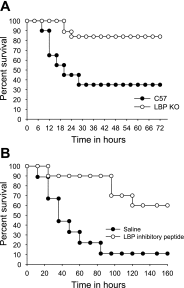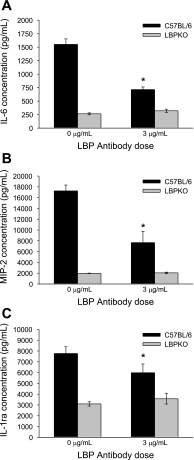LPS-binding protein mediates LPS-induced liver injury and mortality in the setting of biliary obstruction
- PMID: 18948440
- PMCID: PMC2636928
- DOI: 10.1152/ajpgi.00041.2008
LPS-binding protein mediates LPS-induced liver injury and mortality in the setting of biliary obstruction
Abstract
It is generally accepted that low levels of lipopolysaccharide (LPS)-binding protein (LBP) augment the cell's response to LPS, whereas high levels of LBP have been shown to inhibit cell responses to LPS. Clinical studies and in vitro work by our group have demonstrated that, in the setting of liver disease, increased or acute-phase levels of LBP may actually potentiate rather than inhibit an overwhelming proinflammatory response. Therefore, in the present studies we sought to determine the role of acute-phase LBP in mediating morbidity and mortality in animals challenged with LPS in the setting of biliary obstruction. Using LBP-deficient mice and LBP blockade in wild-type mice, we demonstrate that high levels of LBP are deleterious in the setting of cholestasis. Following biliary obstruction and intraperitoneal LPS challenge, hepatic injury, hepatic neutrophil infiltration, and mortality were significantly increased in animals with an intact LBP acute-phase response. Kupffer cell responses from these animals demonstrated a significant increase in several inflammatory mediators, and Kupffer cell-associated LBP appears to be responsible for these differences, at least in part. Our results indicate that the role of LBP signaling in inflammatory conditions is complex and heterogeneous, and elevated levels of LBP are not always protective. Increased LBP production in the setting of cholestatic liver disease appears to be deleterious and may represent a potential therapeutic target for preventing overwhelming inflammatory responses to LPS in this setting.
Figures









References
-
- Albillos A, de-la-Hera A, Alvarez-Mon M. Serum lipopolysaccharide-binding protein prediction of severe bacterial infection in cirrhotic patients with ascites. Lancet 363: 1608–1610, 2004. - PubMed
-
- Albillos A, de la Hera A, Gonzalez M, Moya JL, Calleja JL, Monserrat J, Ruiz-del-Arbol L, Alvarez-Mon M. Increased lipopolysaccharide binding protein in cirrhotic patients with marked immune and hemodynamic derangement. Hepatology 37: 208–217, 2003. - PubMed
-
- Arana M de J, Vallespi MG, Chinea G, Vallespi GV, Rodriguez-Alonso I, Garay HE, Buurman WA, Reyes O. Inhibition of LPS-responses by synthetic peptides derived from LBP associates with the ability of the peptides to block LBP-LPS interaction. J Endotoxin Res 9: 281–291, 2003. - PubMed
-
- Blamey SL, Fearon KC, Gilmour WH, Osborne DH, Carter DC. Prediction of risk in biliary surgery. Br J Surg 70: 535–538, 1983. - PubMed
-
- Copeland S, Siddiqui J, Remick D. Direct comparison of traditional ELISAs and membrane protein arrays for detection and quantification of human cytokines. J Immunol Methods 284: 99–106, 2004. - PubMed
Publication types
MeSH terms
Substances
Grants and funding
LinkOut - more resources
Full Text Sources
Medical
Molecular Biology Databases
Miscellaneous

